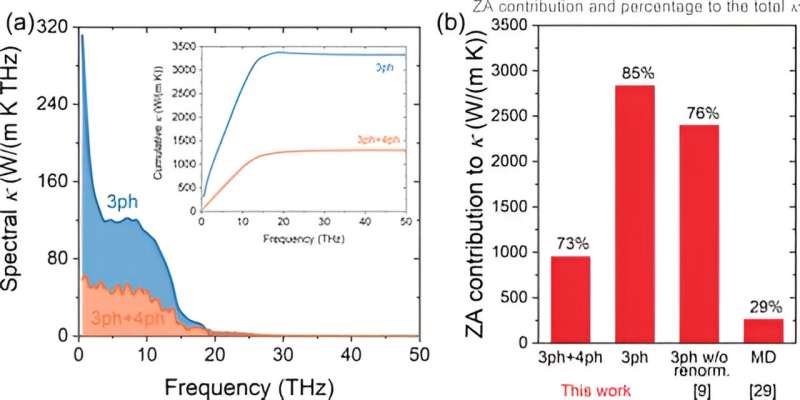Graphene, a material which consists of a single layer of carbon atoms, has been celebrated by many as the “next big thing” in material science. But according to Purdue University researchers, its thermal properties may not be as revolutionary as previously thought.
“Graphene is the first two-dimensional material that human beings ever created,” said Xiulin Ruan, professor of mechanical engineering. “It’s basically a layer of carbon, one atom thick. It was first discovered in 2004 and won the Nobel Prize for Physics in 2010. Ever since then, it’s been studied by many researchers because of its unique properties.”
For example, graphene is said to conduct electricity better than any other material known to science and is known for its material strength. Thermal transport researchers were also quick to give it the title of best heat conductor.
“Previously, the material thought to have the highest thermal conductivity was diamond,” said Zherui Han, a Ph.D. student in Ruan’s lab. “That’s the material that can transfer the most heat the quickest. But when graphene came out, mainstream studies showed it to be much better than diamond.”
Thermal conductivity is measured in watts per meter per Kelvin. On this scale, a diamond’s thermal conductivity is generally understood to be about 2,000. But when scientists started measuring graphene’s thermal conductivity, early estimates reached above 5,000. Obviously, this caught the interest of scientists like Ruan, whose research focuses on heat transfer.
“However, subsequent experimental measurements and modeling have refined graphene’s thermal conductivity,” Ruan said. “More recent papers brought the number to around 3,000, which is still quite better than diamond. But we found something altogether different.”
Ruan’s team has predicted the thermal conductivity of graphene at room temperature to be 1,300 W/(m K)—not only less than diamond but also less than the raw graphite material that graphene is made from.
Their research has been published in Physical Review B.
The disparity between their work and previous work comes down to a phenomenon called four-phonon scattering. Phonons are how heat transfer scientists describe the movement of heat in solids on a quantum-mechanical level. Until recently, researchers could only understand three-phonon scattering to predict the transfer of heat through solids.
But in 2016, Ruan’s team developed a general theory of four-phonon scattering, and a year later they successfully quantified four-phonon scattering. This led to Ruan receiving the highest honor from the International Phononics Society in 2023.
So, how does this relate to graphene? “Graphene is a two-dimensional material of only one atom thick,” Han said.
“Previous studies suggest that three-phonon scattering would be restricted by this two-dimensionality, which in theory makes graphene much more thermally conductive than bulk materials. But four-phonon scattering is not restricted by the 2D nature of graphene; in fact, the effect is quite strong. Our work has shown that four-phonon scattering becomes the leading scattering channel in graphene over three-phonon scattering. This is a striking result.”
One barrier to this discovery was the availability of raw computing power. Calculating this four-phonon scattering required a parallel computing strategy, essentially utilizing a computing cluster with one terabyte of memory. This was accomplished at the Rosen Center for Advanced Computing at Purdue University.
At the moment, these calculations are all theoretical. The team works with Prof. Li Shi at the University of Texas at Austin, supported by their collaborative National Science Foundation grants, to verify the findings experimentally. Previous measurements on graphene have had large error bars, which need to be reduced to verify their theory. They also plan to predict the thermal conductivity of graphene of multiple layers of atoms, rather than just one.
“Without experimental validations as yet, we know the community will be skeptical about this very non-mainstream prediction,” Ruan said.
“We faced the same skepticism in 2017 when we predicted similar aspects of boron arsenide. Fortunately, that prediction was confirmed by three important experiments a year later. Since then, our four-phonon scattering theory has been supported by more and more experimental evidence, and we hope it will hold for graphene as well this time. We make our software open source so other scientists can test the four-phonon theory.”
Zherui Han has posted his four-phonon thermal conductivity solver on GitHub and published a paper describing the software’s usage. Any heat transfer scientist can use the software to conduct similar research.
“Graphene being the first two-dimensional material, many people thought it was like magic,” Han said. “It was believed to have all these superior properties: thermal, mechanical, optical, electrical. As thermal researchers, it’s our job to establish whether that part is true. Graphene is still a good heat conductor, but our work predicts it’s not better than diamond.”
“I always say exceptions are how science moves forward,” Ruan said. “We are cautiously optimistic about our findings. With four-phonon scattering, it’s our hope to deliver much more accurate theoretical assessments of these materials in the future.”


